Nan Yin
LightSAM: Parameter-Agnostic Sharpness-Aware Minimization
May 30, 2025Abstract:Sharpness-Aware Minimization (SAM) optimizer enhances the generalization ability of the machine learning model by exploring the flat minima landscape through weight perturbations. Despite its empirical success, SAM introduces an additional hyper-parameter, the perturbation radius, which causes the sensitivity of SAM to it. Moreover, it has been proved that the perturbation radius and learning rate of SAM are constrained by problem-dependent parameters to guarantee convergence. These limitations indicate the requirement of parameter-tuning in practical applications. In this paper, we propose the algorithm LightSAM which sets the perturbation radius and learning rate of SAM adaptively, thus extending the application scope of SAM. LightSAM employs three popular adaptive optimizers, including AdaGrad-Norm, AdaGrad and Adam, to replace the SGD optimizer for weight perturbation and model updating, reducing sensitivity to parameters. Theoretical results show that under weak assumptions, LightSAM could converge ideally with any choices of perturbation radius and learning rate, thus achieving parameter-agnostic. We conduct preliminary experiments on several deep learning tasks, which together with the theoretical findings validate the the effectiveness of LightSAM.
Cross-Attention Graph Neural Networks for Inferring Gene Regulatory Networks with Skewed Degree Distribution
Dec 24, 2024Abstract:Inferencing Gene Regulatory Networks (GRNs) from gene expression data is a pivotal challenge in systems biology, and several innovative computational methods have been introduced. However, most of these studies have not considered the skewed degree distribution of genes. Specifically, some genes may regulate multiple target genes while some genes may be regulated by multiple regulator genes. Such a skewed degree distribution issue significantly complicates the application of directed graph embedding methods. To tackle this issue, we propose the Cross-Attention Complex Dual Graph Embedding Model (XATGRN). Our XATGRN employs a cross-attention mechanism to effectively capture intricate gene interactions from gene expression profiles. Additionally, it uses a Dual Complex Graph Embedding approach to manage the skewed degree distribution, thereby ensuring precise prediction of regulatory relationships and their directionality. Our model consistently outperforms existing state-of-the-art methods across various datasets, underscoring its efficacy in elucidating complex gene regulatory mechanisms. Our codes used in this paper are publicly available at: https://github.com/kikixiong/XATGRN.
SGAC: A Graph Neural Network Framework for Imbalanced and Structure-Aware AMP Classification
Dec 20, 2024Abstract:Classifying antimicrobial peptides(AMPs) from the vast array of peptides mined from metagenomic sequencing data is a significant approach to addressing the issue of antibiotic resistance. However, current AMP classification methods, primarily relying on sequence-based data, neglect the spatial structure of peptides, thereby limiting the accurate classification of AMPs. Additionally, the number of known AMPs is significantly lower than that of non-AMPs, leading to imbalanced datasets that reduce predictive accuracy for AMPs. To alleviate these two limitations, we first employ Omegafold to predict the three-dimensional spatial structures of AMPs and non-AMPs, constructing peptide graphs based on the amino acids' C$_\alpha$ positions. Building upon this, we propose a novel classification model named Spatial GNN-based AMP Classifier (SGAC). Our SGAC model employs a graph encoder based on Graph Neural Networks (GNNs) to process peptide graphs, generating high-dimensional representations that capture essential features from the three-dimensional spatial structure of amino acids. Then, to address the inherent imbalanced datasets, SGAC first incorporates Weight-enhanced Contrastive Learning, which clusters similar peptides while ensuring separation between dissimilar ones, using weighted contributions to emphasize AMP-specific features. Furthermore, SGAC employs Weight-enhanced Pseudo-label Distillation to dynamically generate high-confidence pseudo labels for ambiguous peptides, further refining predictions and promoting balanced learning between AMPs and non-AMPs. Experiments on publicly available AMP and non-AMP datasets demonstrate that SGAC significantly outperforms traditional sequence-based methods and achieves state-of-the-art performance among graph-based models, validating its effectiveness in AMP classification.
Relieving Universal Label Noise for Unsupervised Visible-Infrared Person Re-Identification by Inferring from Neighbors
Dec 16, 2024Abstract:Unsupervised visible-infrared person re-identification (USL-VI-ReID) is of great research and practical significance yet remains challenging due to the absence of annotations. Existing approaches aim to learn modality-invariant representations in an unsupervised setting. However, these methods often encounter label noise within and across modalities due to suboptimal clustering results and considerable modality discrepancies, which impedes effective training. To address these challenges, we propose a straightforward yet effective solution for USL-VI-ReID by mitigating universal label noise using neighbor information. Specifically, we introduce the Neighbor-guided Universal Label Calibration (N-ULC) module, which replaces explicit hard pseudo labels in both homogeneous and heterogeneous spaces with soft labels derived from neighboring samples to reduce label noise. Additionally, we present the Neighbor-guided Dynamic Weighting (N-DW) module to enhance training stability by minimizing the influence of unreliable samples. Extensive experiments on the RegDB and SYSU-MM01 datasets demonstrate that our method outperforms existing USL-VI-ReID approaches, despite its simplicity. The source code is available at: https://github.com/tengxiao14/Neighbor-guided-USL-VI-ReID.
Graph Structure Learning with Bi-level Optimization
Nov 26, 2024Abstract:Currently, most Graph Structure Learning (GSL) methods, as a means of learning graph structure, improve the robustness of GNN merely from a local view by considering the local information related to each edge and indiscriminately applying the mechanism across edges, which may suffer from the local structure heterogeneity of the graph (\ie the uneven distribution of inter-class connections over nodes). To overcome the cons, we extract the graph structure as a learnable parameter and jointly learn the structure and common parameters of GNN from the global view. Excitingly, the common parameters contain the global information for nodes features mapping, which is also crucial for structure optimization (\ie optimizing the structure relies on global mapping information). Mathematically, we apply a generic structure extractor to abstract the graph structure and transform GNNs in the form of learning structure and common parameters. Then, we model the learning process as a novel bi-level optimization, \ie \textit{Generic Structure Extraction with Bi-level Optimization for Graph Structure Learning (GSEBO)}, which optimizes GNN parameters in the upper level to obtain the global mapping information and graph structure is optimized in the lower level with the global information learned from the upper level. We instantiate the proposed GSEBO on classical GNNs and compare it with the state-of-the-art GSL methods. Extensive experiments validate the effectiveness of the proposed GSEBO on four real-world datasets.
AGLP: A Graph Learning Perspective for Semi-supervised Domain Adaptation
Nov 20, 2024Abstract:In semi-supervised domain adaptation (SSDA), the model aims to leverage partially labeled target domain data along with a large amount of labeled source domain data to enhance its generalization capability for the target domain. A key advantage of SSDA is its ability to significantly reduce reliance on labeled data, thereby lowering the costs and time associated with data preparation. Most existing SSDA methods utilize information from domain labels and class labels but overlook the structural information of the data. To address this issue, this paper proposes a graph learning perspective (AGLP) for semi-supervised domain adaptation. We apply the graph convolutional network to the instance graph which allows structural information to propagate along the weighted graph edges. The proposed AGLP model has several advantages. First, to the best of our knowledge, this is the first work to model structural information in SSDA. Second, the proposed model can effectively learn domain-invariant and semantic representations, reducing domain discrepancies in SSDA. Extensive experimental results on multiple standard benchmarks demonstrate that the proposed AGLP algorithm outperforms state-of-the-art semi-supervised domain adaptation methods.
GraphCL: Graph-based Clustering for Semi-Supervised Medical Image Segmentation
Nov 20, 2024



Abstract:Semi-supervised learning (SSL) has made notable advancements in medical image segmentation (MIS), particularly in scenarios with limited labeled data and significantly enhancing data utilization efficiency. Previous methods primarily focus on complex training strategies to utilize unlabeled data but neglect the importance of graph structural information. Different from existing methods, we propose a graph-based clustering for semi-supervised medical image segmentation (GraphCL) by jointly modeling graph data structure in a unified deep model. The proposed GraphCL model enjoys several advantages. Firstly, to the best of our knowledge, this is the first work to model the data structure information for semi-supervised medical image segmentation (SSMIS). Secondly, to get the clustered features across different graphs, we integrate both pairwise affinities between local image features and raw features as inputs. Extensive experimental results on three standard benchmarks show that the proposed GraphCL algorithm outperforms state-of-the-art semi-supervised medical image segmentation methods.
DiM: $f$-Divergence Minimization Guided Sharpness-Aware Optimization for Semi-supervised Medical Image Segmentation
Nov 19, 2024Abstract:As a technique to alleviate the pressure of data annotation, semi-supervised learning (SSL) has attracted widespread attention. In the specific domain of medical image segmentation, semi-supervised methods (SSMIS) have become a research hotspot due to their ability to reduce the need for large amounts of precisely annotated data. SSMIS focuses on enhancing the model's generalization performance by leveraging a small number of labeled samples and a large number of unlabeled samples. The latest sharpness-aware optimization (SAM) technique, which optimizes the model by reducing the sharpness of the loss function, has shown significant success in SSMIS. However, SAM and its variants may not fully account for the distribution differences between different datasets. To address this issue, we propose a sharpness-aware optimization method based on $f$-divergence minimization (DiM) for semi-supervised medical image segmentation. This method enhances the model's stability by fine-tuning the sensitivity of model parameters and improves the model's adaptability to different datasets through the introduction of $f$-divergence. By reducing $f$-divergence, the DiM method not only improves the performance balance between the source and target datasets but also prevents performance degradation due to overfitting on the source dataset.
DuSEGO: Dual Second-order Equivariant Graph Ordinary Differential Equation
Nov 15, 2024
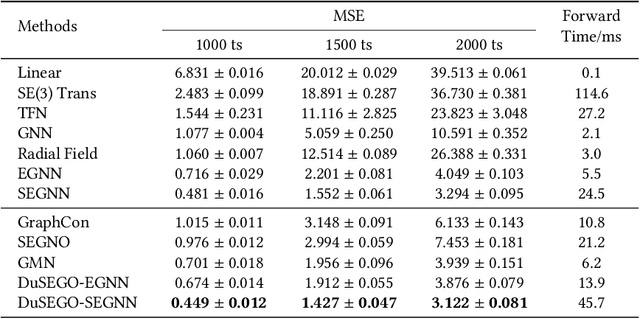
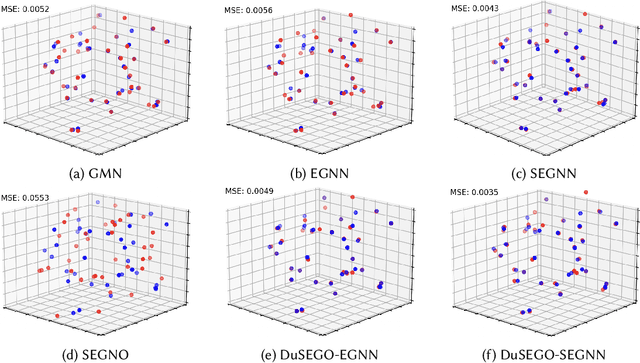
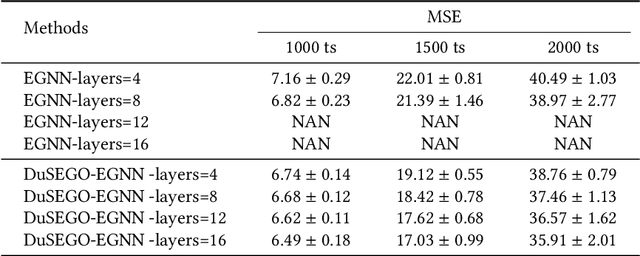
Abstract:Graph Neural Networks (GNNs) with equivariant properties have achieved significant success in modeling complex dynamic systems and molecular properties. However, their expressiveness ability is limited by: (1) Existing methods often overlook the over-smoothing issue caused by traditional GNN models, as well as the gradient explosion or vanishing problems in deep GNNs. (2) Most models operate on first-order information, neglecting that the real world often consists of second-order systems, which further limits the model's representation capabilities. To address these issues, we propose the \textbf{Du}al \textbf{S}econd-order \textbf{E}quivariant \textbf{G}raph \textbf{O}rdinary Differential Equation (\method{}) for equivariant representation. Specifically, \method{} apply the dual second-order equivariant graph ordinary differential equations (Graph ODEs) on graph embeddings and node coordinates, simultaneously. Theoretically, we first prove that \method{} maintains the equivariant property. Furthermore, we provide theoretical insights showing that \method{} effectively alleviates the over-smoothing problem in both feature representation and coordinate update. Additionally, we demonstrate that the proposed \method{} mitigates the exploding and vanishing gradients problem, facilitating the training of deep multi-layer GNNs. Extensive experiments on benchmark datasets validate the superiority of the proposed \method{} compared to baselines.
Degree Distribution based Spiking Graph Networks for Domain Adaptation
Oct 10, 2024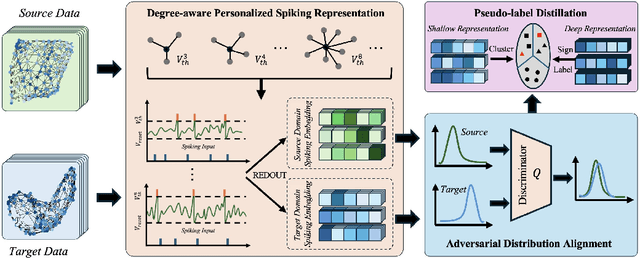
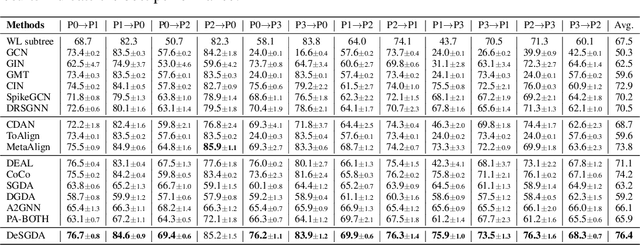

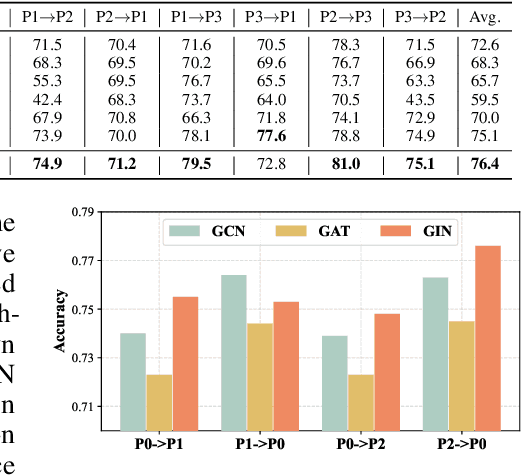
Abstract:Spiking Graph Networks (SGNs) have garnered significant attraction from both researchers and industry due to their ability to address energy consumption challenges in graph classification. However, SGNs are only effective for in-distribution data and cannot tackle out-of-distribution data. In this paper, we first propose the domain adaptation problem in SGNs, and introduce a novel framework named Degree-aware Spiking Graph Domain Adaptation for Classification. The proposed DeSGDA addresses the spiking graph domain adaptation problem by three aspects: node degree-aware personalized spiking representation, adversarial feature distribution alignment, and pseudo-label distillation. First, we introduce the personalized spiking representation method for generating degree-dependent spiking signals. Specifically, the threshold of triggering a spike is determined by the node degree, allowing this personalized approach to capture more expressive information for classification. Then, we propose the graph feature distribution alignment module that is adversarially trained using membrane potential against a domain discriminator. Such an alignment module can efficiently maintain high performance and low energy consumption in the case of inconsistent distribution. Additionally, we extract consistent predictions across two spaces to create reliable pseudo-labels, effectively leveraging unlabeled data to enhance graph classification performance. Extensive experiments on benchmark datasets validate the superiority of the proposed DeSGDA compared with competitive baselines.
 Add to Chrome
Add to Chrome Add to Firefox
Add to Firefox Add to Edge
Add to Edge